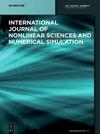Numerical Simulations and Research of Heat Transfer in Pneumatic Pulsator
IF 1.5
4区 工程技术
Q2 ENGINEERING, MULTIDISCIPLINARY
International Journal of Nonlinear Sciences and Numerical Simulation
Pub Date : 2015-06-01
DOI:10.1515/ijnsns-2014-0012
引用次数: 3
Abstract
Abstract In loose material beds above silo outlets or in vertical channels immovable vaults can occur limiting or making impossible the downward movement of the loose material. To prevent vault creation or to destroy vault by aeration and separation of the loose material from encasing walls, a pneumatic pulsator can be applied. In order to optimize the head design, the flow phenomena were numerically simulated and the channels were preliminarily designed. The data obtained from simulation were also used as a basis for setting up an experimental stand to validate simulation results. During air flow in the channels due to frictional heat is produced, which is discharged from the pulsator to the environment. To increase the heat transfer in pneumatic pulsator, the external surfaces of channel are finned. Numerical simulations carried out conduction and convection heat transfer in the fins, and the results illustrated the temperature distribution on the surface of the body, the temperature distribution in the fins, stress distribution, value of factor of safety, the static displacement of the body and the distribution of air temperature along with the speed vectors. The results were compared with experimental and analytical results that confirm their correctness. The results confirm the rational design of the body in terms of thermal. The obtained temperature distribution using CFD agrees approximately with the values measured during the tests.气动脉动器传热数值模拟与研究
在料仓出口上方的松散物料层或垂直通道中,会出现不可移动的拱顶,限制或不可能使松散物料向下运动。为了防止拱顶形成或通过通风和从包围壁分离松散物质来破坏拱顶,可以使用气动脉动器。为了优化封头设计,对封头的流动现象进行了数值模拟,并对封头的流道进行了初步设计。并以模拟所得数据为基础,建立了实验台架,对模拟结果进行了验证。在通道内的空气流动过程中,由于产生摩擦热,这些摩擦热从脉动器排放到环境中。为了增加气动脉动器的换热,在通道外表面加装翅片。通过数值模拟,对翅片进行了导热和对流换热,得到了机身表面温度分布、翅片内部温度分布、应力分布、安全系数值、机身静态位移以及空气温度随速度矢量的分布情况。将所得结果与实验和分析结果进行了比较,验证了所得结果的正确性。结果证实了机体在散热方面的合理设计。利用CFD计算得到的温度分布与试验测量值基本吻合。
本文章由计算机程序翻译,如有差异,请以英文原文为准。
求助全文
约1分钟内获得全文
求助全文
来源期刊
CiteScore
2.80
自引率
6.70%
发文量
117
审稿时长
13.7 months
期刊介绍:
The International Journal of Nonlinear Sciences and Numerical Simulation publishes original papers on all subjects relevant to nonlinear sciences and numerical simulation. The journal is directed at Researchers in Nonlinear Sciences, Engineers, and Computational Scientists, Economists, and others, who either study the nature of nonlinear problems or conduct numerical simulations of nonlinear problems.

 求助内容:
求助内容: 应助结果提醒方式:
应助结果提醒方式:


